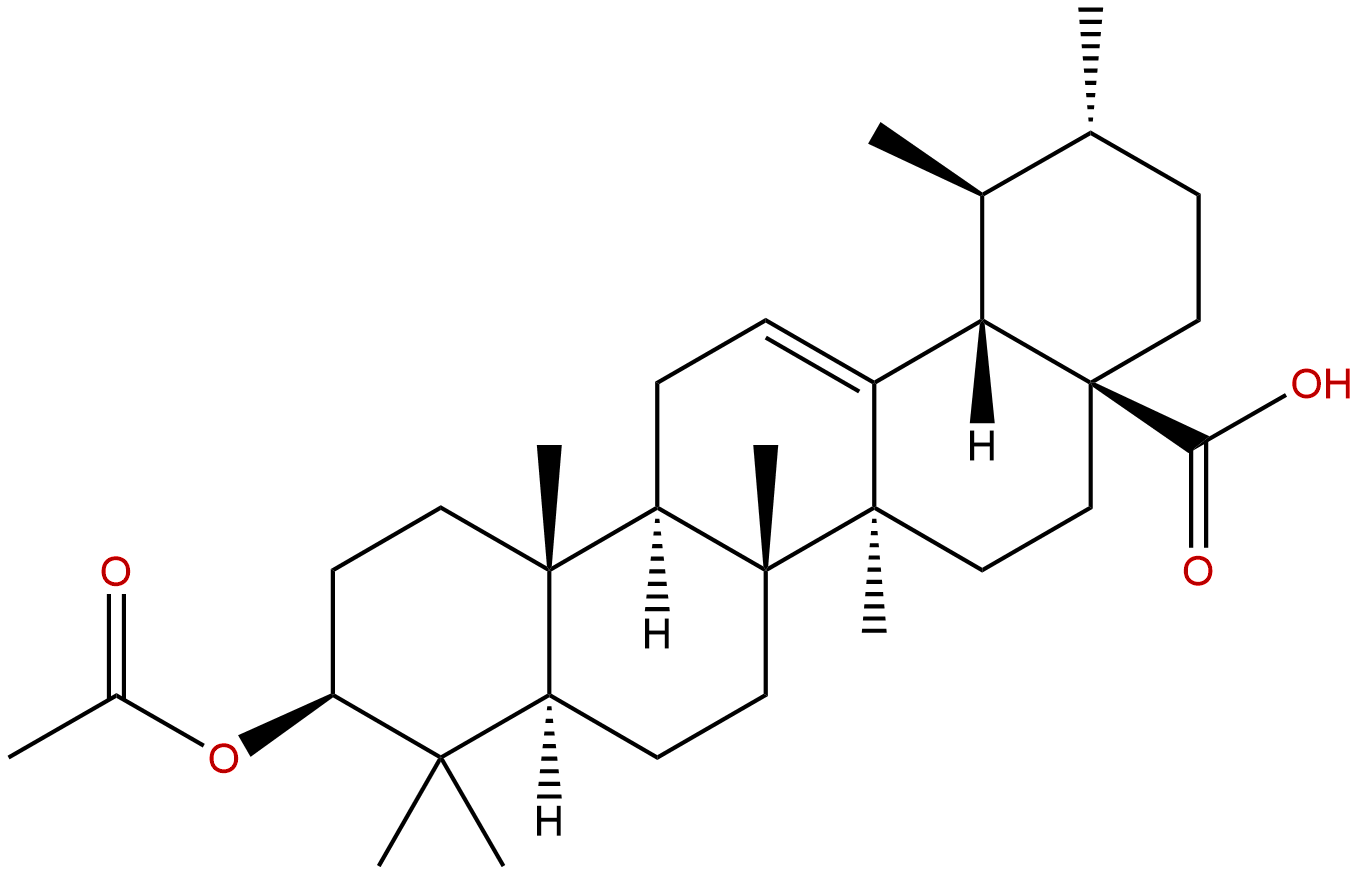
3-acetylursolic acidCAS No.:7372-30-7
|
||||||||||
 |
|
|
||||||||

| Catalogue No.: | BP3024 |
| Formula: | C32H50O4 |
| Mol Weight: | 498.748 |
Product name: 3-acetylursolic acid
Synonym name:
Catalogue No.: BP3024
Cas No.: 7372-30-7
Formula: C32H50O4
Mol Weight: 498.748
Botanical Source:
Physical Description: Powder
Type of Compound: Triterpenoids
Purity: 95%~99%
Analysis Method: HPLC-DAD or/and HPLC-ELSD
Identification Method: Mass, NMR
Packing: Brown vial or HDPE plastic bottle
The product could be supplied from milligrams to grams. Inquire for bulk scale.
We provide solution to improve the water-solubility of compounds, thereby facilitating the variety of activity tests and clinic uses.
For Reference Standard and R&D, Not for Human Use Directly.
Description:
Acetylursolic acid shows significant cytotoxic activities, and shows suppression of the SOS-inducing activity of mutagenic heterocyclic amine, Trp-P-1. 3β-Acetylursolic acid can reduce parasitaemia against Plasmodium berghei.
References:
Phytochemistry. 2005 Feb;66(4):495-501.
Cytotoxic triterpenes from the aerial roots of Ficus microcarpa.
METHODS AND RESULTS:
Six triterpenes, 3beta-acetoxy-12,19-dioxo-13(18)-oleanene (1), 3beta-acetoxy-19(29)-taraxasten-20alpha-ol (2), 3beta-acetoxy-21alpha,22alpha-epoxytaraxastan-20alpha-ol (3), 3,22-dioxo-20-taraxastene (4), 3beta-acetoxy-11alpha,12alpha-epoxy-16-oxo-14-taraxerene (5), 3beta-acetoxy-25-methoxylanosta-8,23-diene (6) along with nine known triterpenes, 3beta-acetoxy-11alpha,12alpha-epoxy-14-taraxerene (7), 3beta-acetoxy-25-hydroxylanosta-8,23-diene (8), oleanonic acid (9), acetylbetulinic acid (10), betulonic acid (11), Acetylursolic acid (12), ursonic acid (13), ursolic acid (14), and 3-oxofriedelan-28-oic acid (15) were isolated from the aerial roots of Ficus microcarpa, and their structures elucidated by spectroscopic methods. The in vitro cytotoxic efficacy of these triterpenes was investigated using three human cancer cell lines, namely, HONE-1 nasopharyngeal carcinoma, KB oral epidermoid carcinoma, and HT29 colorectal carcinoma cells.
CONCLUSIONS:
Compound 8 and pentacyclic triterpenes 9-15 possessing a carboxylic acid functionality at C-28 showed significant cytotoxic activities against the aforementioned cell lines and gave IC50 values in the range 4.0-9.4 microM.
J Agric Food Chem. 2005 Mar 23;53(6):2312-5.
Suppression of the SOS-inducing activity of mutagenic heterocyclic amine, Trp-P-1, by triterpenoid from Uncaria sinensis in the Salmonella typhimurium TA1535/pSK1002 Umu test.
METHODS AND RESULTS:
The methanol extract from Uncaria sinensis showed a suppressive effect on umu gene expression of the SOS response in Salmonella typhimurium TA1535/pSK1002 against the mutagen 3-amino-1,4-dimethyl-5H-pyrido[4,3b]indole (Trp-P-1), which requires liver metabolizing enzymes. The methanol extract from U. sinensis was re-extracted with hexane, CH2Cl2, BuOH, and water, respectively. CH2Cl2 extract showed a suppressive effect. A suppressive compound 1 in CH2Cl2 extract was isolated by SiO2 column chromatography. Compound 1 was identified as ursolic acid by IR, electron ionization EI-MS, and NMR spectroscopy. Suppressive effects of ursolic acid (1) and its derivatives, methyl ursolate (1M), Acetylursolic acid (1A), and methyl acetylursolate (1MA), were determined in the umu test.
CONCLUSIONS:
These compounds suppressed 61.3, 37.7, 71.5, and 37.8% of the Trp-P-1-induced SOS response at a concentration of 0.4 micromol/mL, respectively. The ID50 values of compounds 1 and 1A were 0.17 and 0.20 micromol/mL. In addition, these compounds were assayed with the activated Trp-P-1. Suppressive effects on activated Trp-P-1 were decreased as compared with those of Trp-P-1.
Molecules. 2013 Oct 8;18(10):12313-23.
Anti-plasmodial activity of some Zulu medicinal plants and of some triterpenes isolated from them.
Mimusops caffra E. Mey. ex A.DC and Mimusops obtusifolia Lam (both members of the Sapotaceae family), and Hypoxis colchicifolia Bak (family Hypoxidaceae) are used by traditional healers in Zululand to manage malaria.
METHODS AND RESULTS:
Anti-plasmodial investigation of the crude extracts and some triterpenes isolated from the plants showed activity against a chloroquine sensitive (CQS) strain of Plasmodium falciparum (D10). Among the crude extracts the leaves of M. caffra exhibited the highest activity, with an IC₅₀ of 2.14 μg/mL. The pentacyclic tritepenoid ursolic acid (1), isolated from the leaves of M. caffra was the most active compound (IC₅₀ 6.8 μg/mL) as compared to taraxerol (2) and sawamilletin (3) isolated from the stem bark of M. obtusifolia (IC₅₀ > 100). Chemical modification of the ursolic acid (1) to 3β-Acetylursolic acid (4) greatly enhanced its anti-plasmodial activity. Compound 4 reduced parasitaemia against Plasmodium berghei by 94.01% in in vivo studies in mice.
CONCLUSIONS:
The cytotoxicity of 3β-Acetylursolic acid (IC₅₀) to two human cell lines (HEK293 and HepG2) was 366.00 μg/mL and 566.09 μg/mL, respectively. The results validate the use of these plants in folk medicine.